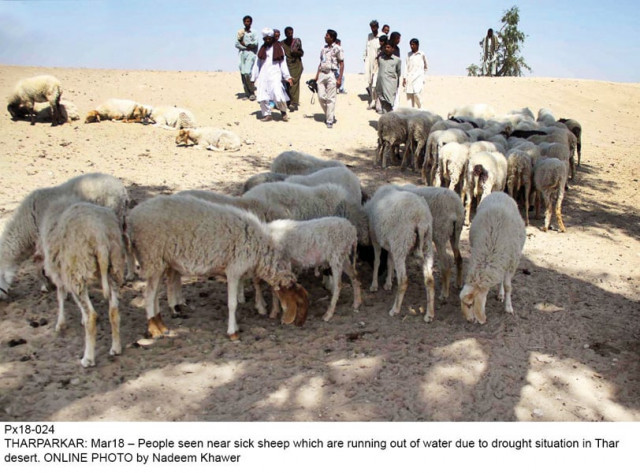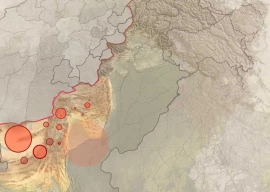
The movement of cattle and livestock along the roads leading t0 Tharpakar is a familiar sight on most days of the year. The sacred relationship between the people of Thar and their animals is almost as old as the desert itself. In this region, it is not agriculture but livestock that is the main source of sustenance for its residents.
According to statistics obtained from the last survey of livestock in 2006, the total number of domesticated animals in the region was 4,593,598. The number has now crossed six million over the last seven years. Meanwhile, there are only 11 veterinary doctors against the 17 sanctioned vacancies.

Over 75 per cent of the animals in Sindh are reportedly in Tharparkar where there is just one doctor to cater to over 600,000 animals. Compare these figures to the Punjab where there is a doctor for every 100,000 animals. “What we lack is planning, advocacy and awareness among the people,” an official of the livestock department said on the condition of anonymity.
The mobilisation of animals between Tharparkar and its adjacent barrage areas, including Badin and Mirpurkhas, is a routine practice. Residents of the barrage areas move their animals to the desert in search of greener pastures during the time of floods, while the people of Tharparkar move their animals when the drought hits parts of the desert. “It is a routine practice. We cannot stay here because our animals will die due to the non-availability of fodder,” Loang, a resident of village Lanjha, Diplo, who owns 40 cattle, told The Express Tribune. He was on his way to Badin with his livestock. Loang revealed that over a dozen of his cows had died in the last three months. “I simply cannot afford for more of my livestock to die.”
According to a survey conducted by a Thar-based organisation, Thardeep, about 42,000 sheep have died in the region between January to March 14. “They have all died because of a viral disease,” believed its chief, Zaffar Junejo. “They have not died because of the drought, but failure of vaccination,” he claimed.
Junejo went on to warn that the situation could deteriorate in the coming days with foot and mouth diseases. He insisted that only proper vaccination could save the thousands of animals in Thar.
According to the residents of Thar, the mobilisation of their animals is interlinked with their labour in the fields of landlords of the barrage areas. “We work on their land and in return, our animals are given fodder and we get some cash as well,” another resident of Mithi taluka, Bachayo, told The Express Tribune. “Our animals are our assets and we cannot take more risk,” he added.
Meanwhile, officials of the livestock department blame the mobilisation of animals as the cause of viral and bacterial diseases in Thar and its adjacent areas. “There is a refusal to vaccinate these animals too,” said an official. He added that there was also a dearth of adequate funding for research and vaccination in the province.
Livestock herding is the single largest source of income for the people of Thar. For them, the death of one animal is an indicator that the disease could spread. “This is all because of the lack of rainfal,” believed Gopal, a resident of village Motatiyon.
Junejo disagreed. “No, it is because of a lack of seriousness on the government’s part. Thar received only 30 per cent less rain this year,” said Junejo, rejecting the arguments of the villagers.
The livestock department’s officials and social activists believe that the animals of Thar could be saved if timely vaccination was carried out. They also urged that the livestock of the area could generate a sizeable revenue if serious efforts were made.
Published in The Express Tribune, March 19th, 2014.











1728386780-0/BeFunky-collage-(38)1728386780-0-270x192.webp)






COMMENTS
Comments are moderated and generally will be posted if they are on-topic and not abusive.
For more information, please see our Comments FAQ